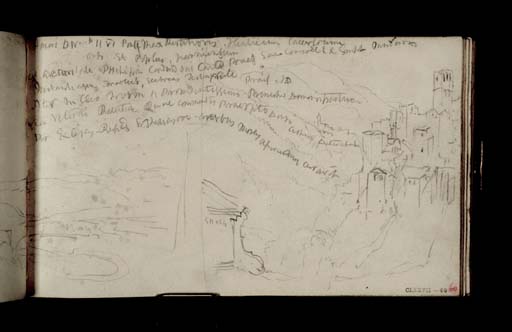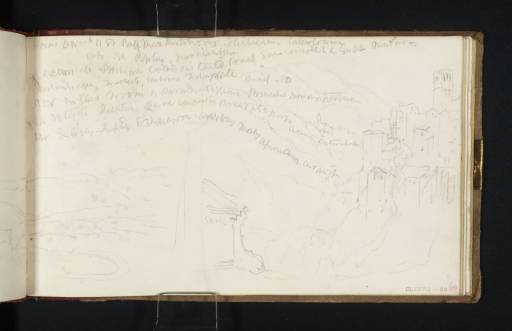Joseph Mallord William Turner View of the Western Edge of Narni, with the Monument and Inscription Commemorating the Building of the Mountain Road by Pope Pius VI 1819
Image 1 of 2
-
 Joseph Mallord William Turner, View of the Western Edge of Narni, with the Monument and Inscription Commemorating the Building of the Mountain Road by Pope Pius VI 1819
Joseph Mallord William Turner, View of the Western Edge of Narni, with the Monument and Inscription Commemorating the Building of the Mountain Road by Pope Pius VI 1819 -
 Joseph Mallord William Turner, View of the Western Edge of Narni, with the Monument and Inscription Commemorating the Building of the Mountain Road by Pope Pius VI 1819 (Enhanced image)Enhanced image
Joseph Mallord William Turner, View of the Western Edge of Narni, with the Monument and Inscription Commemorating the Building of the Mountain Road by Pope Pius VI 1819 (Enhanced image)Enhanced image
Joseph Mallord William Turner,
View of the Western Edge of Narni, with the Monument and Inscription Commemorating the Building of the Mountain Road by Pope Pius VI
1819
Joseph Mallord William Turner 1775–1851
Folio 60 Recto:
View of the Western Edge of Narni, with the Monument and Inscription Commemorating the Building of the Mountain Road by Pope Pius VI 1819
D14769
Turner Bequest CLXXVII 60
Turner Bequest CLXXVII 60
Pencil on white wove paper, 110 x 186 mm
Inscribed by the artist in pencil ‘Honori DN. PII. VI Ponte Max Restitvoris. Flectiium saecvlorvm | ordo. Et. Poplus. narniensium | ex avctoritate. PHilippi Carandini Card Praef Sac Consili X Sumpt Minvend | Instantiaque fabrici sceberas testerrate praef ID | Iter in clio novvum A providentissimo Principe Demonstratum | Via Veterai Relictia Quae commantes praevpto Dorso Aspera Deterbat | Per Excisas Rupes suspensasore Arcvbus Moles aperiendum curavit’ across top of page
Inscribed by John Ruskin in red ink ‘60’ bottom right
Stamped in black ‘CLXXVII 60’ bottom right
Inscribed by the artist in pencil ‘Honori DN. PII. VI Ponte Max Restitvoris. Flectiium saecvlorvm | ordo. Et. Poplus. narniensium | ex avctoritate. PHilippi Carandini Card Praef Sac Consili X Sumpt Minvend | Instantiaque fabrici sceberas testerrate praef ID | Iter in clio novvum A providentissimo Principe Demonstratum | Via Veterai Relictia Quae commantes praevpto Dorso Aspera Deterbat | Per Excisas Rupes suspensasore Arcvbus Moles aperiendum curavit’ across top of page
Inscribed by John Ruskin in red ink ‘60’ bottom right
Stamped in black ‘CLXXVII 60’ bottom right
Accepted by the nation as part of the Turner Bequest 1856
References
1909
A.J. Finberg, A Complete Inventory of the Drawings of the Turner Bequest, London 1909, vol.I, p.522, as ‘Narni; two sketches’.
1984
Cecilia Powell, ‘Turner on Classic Ground: His Visits to Central and Southern Italy and Related Paintings and Drawings’, unpublished Ph.D thesis, Courtauld Institute of Art, University of London 1984, pp. 101, 469 note 143, 409, (as ‘View at the edge of Narni, present-day Via Vittorio Emanuele, with the inscription commemorating the building of the new road through the mountains in 1791’).
1987
Cecilia Powell, Turner in the South: Rome, Naples, Florence, New Haven and London 1987, p.34.
2008
James Hamilton, Nicola Moorby, Christopher Baker and others, Turner e l’Italia, exhibition catalogue, Palazzo dei Diamanti, Ferrara 2008, pp.44, 90 note 29.
2009
James Hamilton, Nicola Moorby, Christopher Baker and others, Turner & Italy, exhibition catalogue, National Galleries of Scotland, Edinburgh 2009, pp.42, 150–1 note 29.
The town of Narni occupies the crest of a hill approximately seven miles south-west of Terni, and fifty miles north of Rome. As was often the case during Turner’s travels, his mode of travelling did not give him much opportunity to stop and explore the centre of the town. The carriage simply followed a predetermined course in an anti-clockwise direction from east to south-west around the walled perimeter. Consequently Turner’s sketches of Narni only relate to views or subjects visible from the road such as the edges of the town and the Bridge of Augustus in the gorge below.
The sketch on the right-hand side of this page depicts the western side of Narni, from a point near the Porta Pietra. The buttresses of the town walls are just visible on the far right-hand side, and the tower which is the tallest point of the skyline is the Torre Campanaria, the campanile of the cathedral. Amidst the hills in the background is the monastery of San Cassiano. In the foreground on the left is part of a marble monument which stands on the side of the road to Rome, the present-day Via Vittorio Emanuele. Along the top of the page Turner has transcribed the Latin inscription from the monument, which commemorates the building of the mountain road from Narni by Pope Pius VI in 1791. The full text is as follows:
ANNO MDCCLXXXXI | HONORI. D. N. PII. VI. PONT. MAX. RESTITVTORIS. FELICIVM. SAECVLORVM | ORDO. ET. POPVLVS. NARNIENSIVM | EX. AVCTORITATE. PHILIPPI. CARANDINI. CARD. PRAEF. SAC. CONSILI. SVMPT. MINVEND | INSTANTIAQVE. FABRICI. SCEBERAS. TESTAFERRATAE PRAEF. I. D. | ITER. IN. CLIVO. NOVVM. A. PROVIDENTISSIMO PRINCIPE. DEMONSTRATVM | VIA VETFRI. RELICTA. QVAE. COMMEANTES. PRAERVPTO. DORSO. ASPERA. DETERREBAT | PER. EXCISAS. RVPES. SVSPEN. SASQVE. ARCVBVS. MOLES. APERIENDVM. CVRAVIT.
On the left-hand side of the page is part of the view of Narni from the opposite sheet of the double-page spread, see folio 59 verso (D14769). The sketch depicts the valley to the east of the town with the River Nera snaking into the distance. Today the picturesque beauty of the view has been completely transformed by the industrialisation of the area around the new town of Narni Scalo.
Nicola Moorby
November 2008
How to cite
Nicola Moorby, ‘View of the Western Edge of Narni, with the Monument and Inscription Commemorating the Building of the Mountain Road by Pope Pius VI 1819 by Joseph Mallord William Turner’, catalogue entry, November 2008, in David Blayney Brown (ed.), J.M.W. Turner: Sketchbooks, Drawings and Watercolours, Tate Research Publication, December 2012, https://www

